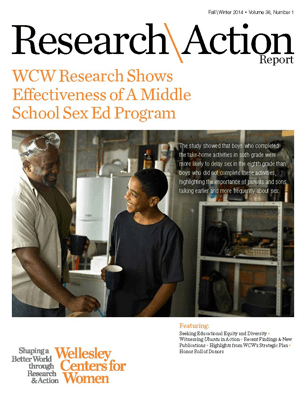
Research & Action Report, Fall/Winter 2014
by Jondou Chase Chen, Ph.D.
As the National SEED Project on Inclusive Curriculum (Seeking Educational Equity and Diversity) approaches its 30th year, we appreciate how our work has developed across time and how it remains grounded in ongoing dialogues between the personal and systemic. Over this same time period, culturally responsive teaching has developed as a major, if not the principal, component of multicultural education deeply informed by critical race theory. SEED sees itself as part of the culturally responsive teaching movement, and through our methodology and in our current social context we are reminded of two needs: first, that culturally responsive teaching lacks depth if teachers themselves are not aware of its relation to critical race theory; and secondly, that teachers must be personally engaged in understanding their own development of racial and cultural identity and how they were schooled to understand race, class, and gender in order to effectively support their students. The personal urgency and the pedagogical necessity of seeking educational equity and diversity serve as SEED’s continued call to action.
1. Multicultural Education’s Evolution toward Culturally Responsive Teaching through Critical Race Theory
Born out of the Civil Rights era, multicultural education has evolved over the past 50 years to include ethnic studies, multiethnic education, the cultural deprivation paradigm, and cultural difference theory and research (Banks, 2013). Personally shaped by the racial events of the 1960s as well as the women’s studies and later the gay rights movements, SEED’s founding leaders recognized and sought to draw attention to the personal experience of educators and the link between individuals’ experiences of identities and oppressive systemic-power dynamics as well as how these linkages are taught both explicitly and implicitly in education. As SEED developed its peer-led seminar model during the early 1980s, it brought together SEED educators who had been and continue to be personally and professionally active in civil rights work regarding race, class, gender, sexual identity, and mental and physical ability.
SEED has fostered decades-long relationships with many educators while continuing to expand its scope because it has addressed current societal issues and provides a platform for life stories shared by SEED participants. SEED’s organizational development mirrors that of multicultural education more broadly, in that each iteration of our work has not resulted in previous iterations disappearing but rather has involved incorporating new facets into our framework. This additive model is not simply historically technical, it is also pedagogical in nature. It reveals an appreciation that culturally responsive teaching is engaging in asset-building and not simply addressing deficits. Or, as Geneva Gay (2013) posits, culturally responsive teaching improves teaching through cultural diversity and is not just teaching to cultural diversity. Promoting culturally diverse assets and agency can help reduce conflict (Stevenson, 2014; Sue, 2010), yet the need for ongoing conversations highlights the ever-changing nature of culture and the depth of the challenge.
Critical racial theory describes how identity-based discrimination continues
to occur because of microagressions and implicit biases even as explicitly racist laws no longer exist (Ladson-Billings, 1998). Seeing token heroes and holidays are not enough (Banks, 2013). In fact, teaching about multiple cultures without a critical view of both power and history can result in further privileging of dominant groups (Ladson-Billings, 1998). At the same time, efforts to move beyond deficit-based thinking are needed to reframe culturally diverse experiences with a broader lens. Indeed, highlighting assets and agency is especially important in that relying solely on negative cultural experiences represents an additional act of oppression (Gay, 2013). As the writer Chimamanda Adichie says, “The problem with stereotypes isn’t that they are untrue, it is that they are incomplete.” SEED seeks to broaden education by both encouraging the inclusion of all stories, including the life-texts of students and teachers, and by drawing attention to the systemic danger of incomplete narratives.
2. SEED Embodies Both Culturally Responsive Teaching and Critical Race Theory
Gay (2013) posits the need for culturally responsive teaching because “beliefs and
attitudes always proceed and shape behavior.” In other words, teaching requires constant attention to both the pedagogical foundation that teachers establish for their teaching as well as to the personal experiences and systemic forces that have and do shape that foundation. SEED co-director Emily Style describes this as the “balancing of the selves and shelves” (2013). As educators, if we are hoping that our teaching might shape our students’ actions, it behooves us to investigate both our own and our students’ experiences and feelings.
Even as responsive teaching falls flat without critical race theory, so too does considering our beliefs and attitudes without acknowledging the experiences and sources that have shaped us and how those experiences were shaped by and continue to shape systemic dynamics. When a white person says that she or he “doesn’t feel safe” in talking about race or when a man says he was “just joking” when an unexamined gender comment falls out of his mouth, they are attempting to sever the link between personal and systemic. Participants in SEED seminars work on unpacking the personal premises of these statements and their systemic consequences. Stories help us realize that we are part of and responsible for something greater than either lives lived in a vacuum or unrealistic rules for political correctness. SEED co-founder Peggy McIntosh, Ph.D. describes this awareness in her Interactive Phase Theory caveat that going around sharing personal stories without thinking systemically is more “sentimental” than substantial (1990).
Additionally, storytelling empowers us to see our selves as change agents. If a person who is accustomed to having their experiences and stories taken seriously and listened to in the marketplace of ideas, their stories are automatically connected to the systemic. If someone shares an experience or story in the marketplace of ideas and it is taken seriously for the first time then it is not merely sentimental it is the beginning of a paradigm shift. That is what SEED does for many communities—as well as creating lenses with which to make links to the systemic. SEED creates a paradigm shift in many school communities where people who’s experience previously has not been taken seriously is now elevated to the place where ideas, policy, curriculum creation exist, the market place of ideas.
3. Maximizing the CRT-CRT connection through “Self-and Shelf” balance
Over the years, a number of SEED participants have identified that our day on “Race,
Ethnicity & Class” is the most powerful day during our New Leaders’ Week because each person further develops self-awareness of racial identity and of systemic racism. We come to appreciate the power of positionality— that our politics of location shape how we are heard relative to how we wish to be heard. “What can I say to make them feel better?” and “What can I say to make them accept me?” are earnest feelings but inadequate questions to address systemic power dynamics. SEED serves as a leader in educational equity by having educators explore our own experience and listen to the personal experience of others, SEED insists that to develop culturally responsive teaching, we must understand critical race theory and history. Our approach to developing such an understanding is through vigilantly mining and sharing our own personal lived experiences with racism as well as other forms of oppression.
SEED embraces educators and community members in all contexts and works with them to become agents and facilitators for change and for equity. The strength of SEED is that it allows people to participate and feel smart and valued due to their lived experience. When people see that their personal light shines on the systemic, their critical awareness and agency are ignited. Through a broad definition of who is worthy to contribute experience, ideas and knowledge, SEED has been effective in bringing people to the table and allowing them to feel competent and comfortable in their seats at every stage, thereby insisting that the table must get bigger and bigger instead of people leaving because they do not have a voice or feel heard.
Conclusion:
While some have questioned the usefulness of SEED’s dialogic methods (Lensmire et al., 2013), recent history suggests otherwise. The past two summers have each featured a major news event highlighting systemic racism. In 2013, the George Zimmerman verdict was released on Race, Ethnicity, & Class day at the SEED training. In 2014, the Michael Brown shooting and subsequent protests occurred in the month after the SEED training. In both instances, we were devastated by the news as a SEED staff, and we were left mourning and questioning the meaning of our work. Guided by the awareness that these news events are simultaneously incredibly personal and systemically representative, we relied on our SEED methodology to provide both the space to do our own processing of these events and the space to realize that we are not alone in this work. In witnessing the listening to others that SEED’s pedagogical methods provide, SEED participants experience the commitment that SEED leaders make toward being the change they want to see. New research (Côté & Krause, 2014) on class differences shows that while people are more likely to socialize with members of their own group, activities such as dialogue poems and sharing early memories of schooling which build conversations around shared experiences and different interpretations can result in stronger relationships across class lines. Our observations at SEED demonstrate that strong relationships can also be built across gender, sexual identity, and race. SEED involves iterative and reciprocal processes, creating SEED leaders who are both critically informed and responsively active in their schools and communities.


